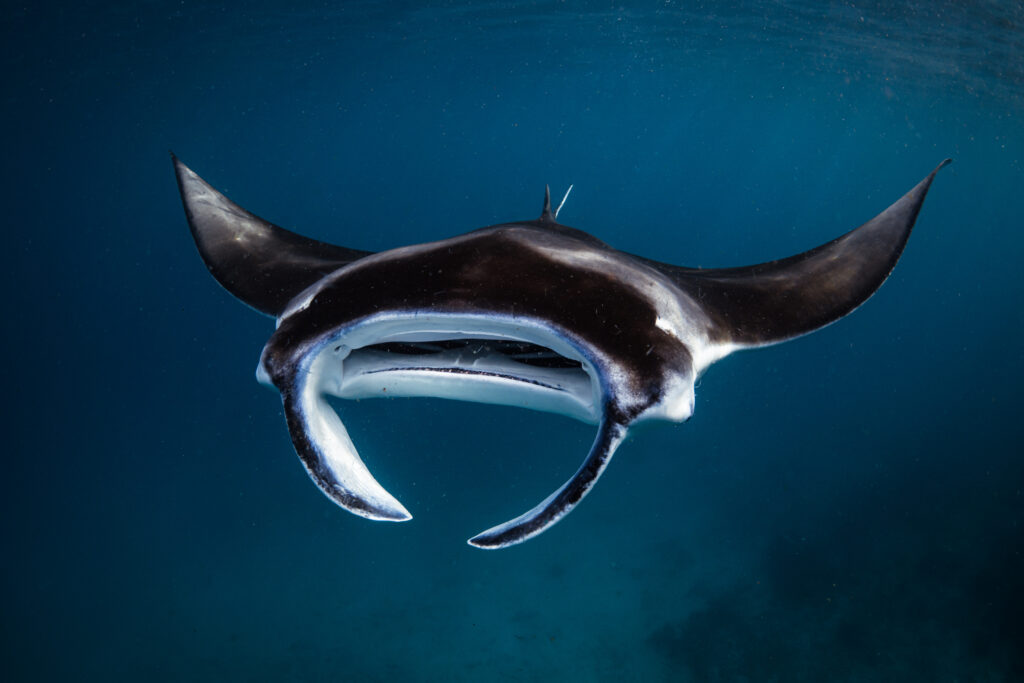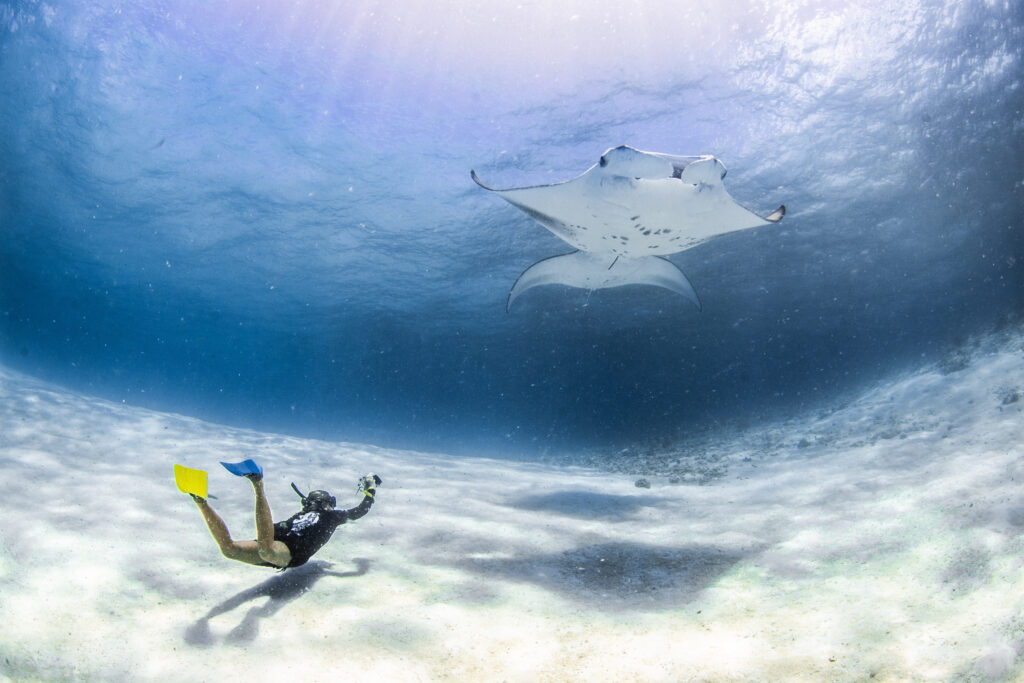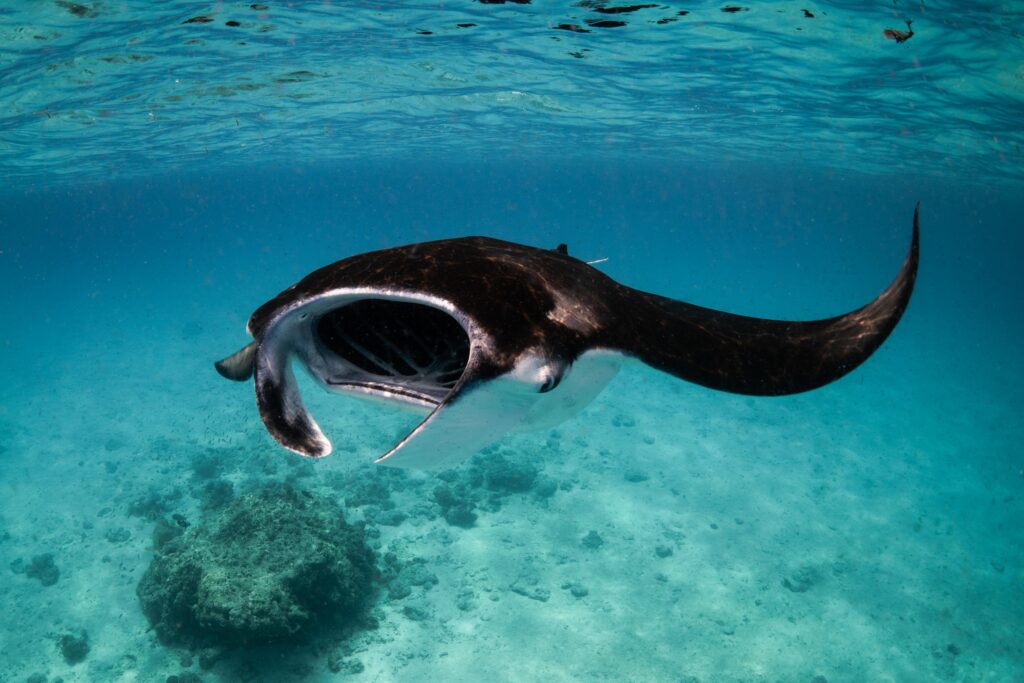HOW TO HAVE A RESPONSIBLE MANTA RAY ENCOUNTER IN THE MALDIVES

Here in the heart of the Indian Ocean, the Maldives is a true haven for marine life. The turquoise waters teem with a vibrant array of underwater treasures, and we feel truly blessed to be surrounded by such natural beauty. From the moment you dip your toes into the warm ocean, you will be immersed in a world unlike anything you have ever experienced.
One of the most captivating sights that grace our waters are the majestic manta rays. These incredible creatures are the epitome of grace and elegance. With their smooth movements and captivating presence, manta rays have become an iconic symbol of the rich marine biodiversity that thrives here in the Maldives. We can not wait for you to witness their beauty firsthand.
Recently, we had the opportunity to sit down with our partners at Maldives Manta Conservation Programme (MMCP) which is the founding project of the Manta Trust. The Manta Trust, a UK based charity, is an organization at the forefront of manta ray conservation efforts globally. Their approach encompasses scientific research, education, and sustainable tourism practices. By working closely with local communities, governments, and tourism operators, the Manta Trust strives to ensure the long-term survival of manta rays.
During our conversation, they shared with us some fascinating and invaluable insights into these graceful creatures. We learned so much about their behavior, habitat, and the efforts being made to protect and conserve their populations.

BEHAVIOR AND CHARACTERISTICS OF MALDIVES MANTA RAYS
Manta rays, scientifically known as Mobula Alfredi (reef manta rays) and Mobula Birostris (oceanic manta rays), are magnificent creatures known for their graceful wing-like fins, which can span up to 4.5m width in reef manta rays and 7m in width for oceanic manta rays. They are predominantly found in warm tropical waters such as the Maldives, particularly in areas such as Baa Atoll, Addu Atoll and Ari Atoll. These gentle giants are attracted to particular areas due to the abundance of plankton, which is their primary food source.
Manta rays are filter feeders, using their large mouths to filter tiny organisms, including plankton, from the water. Despite their enormous size, they pose no threat to humans, as they are completely harmless with sand-paper-like teeth and no stinger in their tails. Their curious and gentle nature often allows for close encounters with humans, making them a favorite among divers and snorkelers.
GUIDELINES FOR RESPECTFUL MANTA RAY ENCOUNTERS IN THE MALDIVES
To safeguard the well-being of manta rays and their natural habitat, the Manta Trust has established a Marine Code of Conduct for scuba divers and snorkelers in the Maldives. By following these guidelines, you can minimize the negative impact on manta rays and contribute to their conservation.
- Approach the water quietly and calmly, ensuring you are at least 10 meters (33 feet) away from the manta ray.
- Keep your fins below the water’s surface while swimming. Excessive splashing and noise can startle the mantas, so it’s important to approach them in a calm manner.
- Maintain a respectful distance of at least 3 meters (10 feet) and remain still, allowing the manta to approach you on its own terms.
- When approaching a manta ray, do so from its side, providing it with a clear and unobstructed path ahead.
- As the manta glides past you, resist the urge to chase after it. Remember, mantas are incredibly swift, and attempting to catch up to them may cause unnecessary stress or fright.
- It is crucial that you refrain from touching manta rays. Physical contact can disrupt their natural behavior and lead to penalties under local laws and regulations.
- If you encounter mantas at a cleaning station while scuba diving, position yourself at the periphery of the station. Avoid swimming or free diving into the main cleaning area, as it is essential for the mantas well-being.
- If you are a scuba diver, you should maintain a low profile and hover close to the seabed, taking care not to harm the delicate reef below. Some dive sites may have designated areas for divers to ensure minimal impact on the environment.
- As a manta approaches you from above, allow it to pass freely without blocking its path. Stay low and remain in your position to avoid obstructing their natural movement.
- In addition to the above guidelines, make sure that you always adhere to any additional rules, laws, or regulations specific to the manta ray site you may be visiting. Respect and follow the local guidelines to ensure these incredible creatures continued protection and preservation.

CHALLENGES AND THREATS FACED BY MANTA RAYS IN THE MALDIVES
While the Maldives offers a haven for manta rays, they face numerous threats daily. Unregulated tourism can have a negative impact, leading to habitat degradation, disturbance, and the alteration of natural behaviors. Additionally, plastic pollution, over fishing, and climate change pose significant risks to their survival. As a conscious traveler, there are several steps you can take to protect manta rays and their habitat:
Choose responsible tour operators: Support local tour operators that prioritize sustainable practices and actively engage in manta ray conservation, such as Secret Paradise Maldives.
Respect their space: When encountering manta rays, maintain a safe distance and avoid touching or chasing them. Allow them to swim freely and undisturbed.
Practice responsible snorkelling and diving: Follow the Marine Code of Conduct provided by the Manta Trust, ensuring you do not harm or disrupt the manta rays or their environment.
Reduce plastic waste: Minimize the use of single-use plastics and properly dispose of waste to prevent pollution in the ocean.
Support conservation efforts: Consider donating to organisations like the Manta Trust or participating in their volunteer programs to contribute directly to manta ray conservation.
The team at Secret Paradise, are not just passionate about creating incredible experiences; we are also deeply committed to preserving the natural wonders that make the Maldives so special. We believe in responsible tourism and actively work to protect and conserve the habitats of these extraordinary creatures. By choosing to explore the Maldives with us, you become an integral part of these conservation efforts, making a positive impact on the environment we all cherish.

WORK TOGETHER TO SAFEGUARD AND PRESERVE
The Marine Code of Conduct for manta rays in the Maldives emphasizes the importance of responsible tourism practices to protect these magnificent creatures. We can all work together to safeguard the beauty and ecological balance of the Maldives marine ecosystem for generations to come by respecting their habitat, following these simple guidelines, and supporting conservation initiatives.
If you are interested in participating in the Manta Trust programs, they offer a wonderful opportunity to actively contribute to the conservation. By getting involved, you not only become a part of the efforts to protect these magnificent creatures but also gain a deeper
understanding of the significance of responsible behavior when observing manta rays. You will have the chance to immerse yourself in ongoing research and conservation initiatives, providing you with invaluable insights into the world of manta rays and their conservation.

For more information, please visit The Manta Trust website.
Images provided by our friends at Manta Trust: Jasmine Corbett, Tam Sawyers, Simon Hilbourne